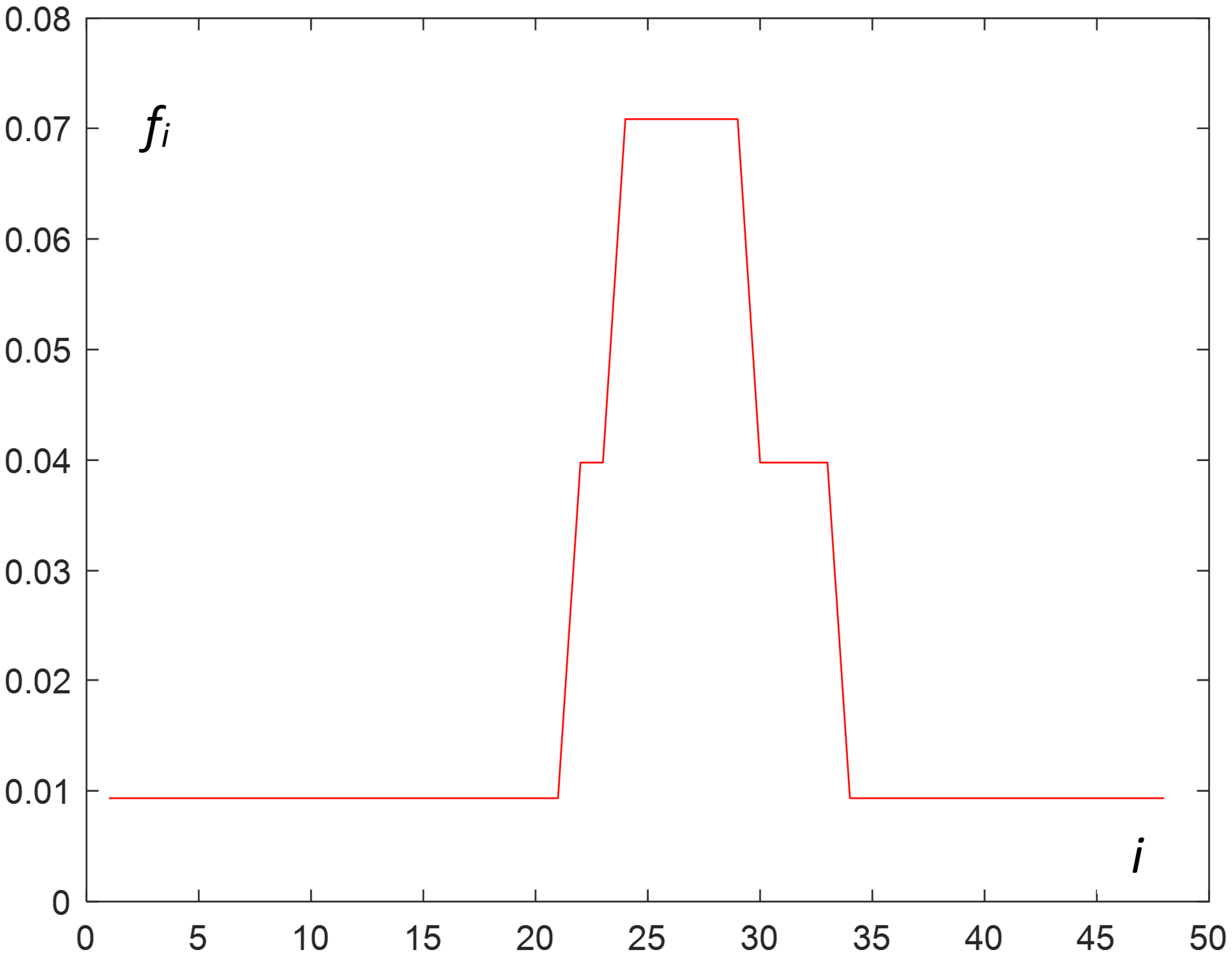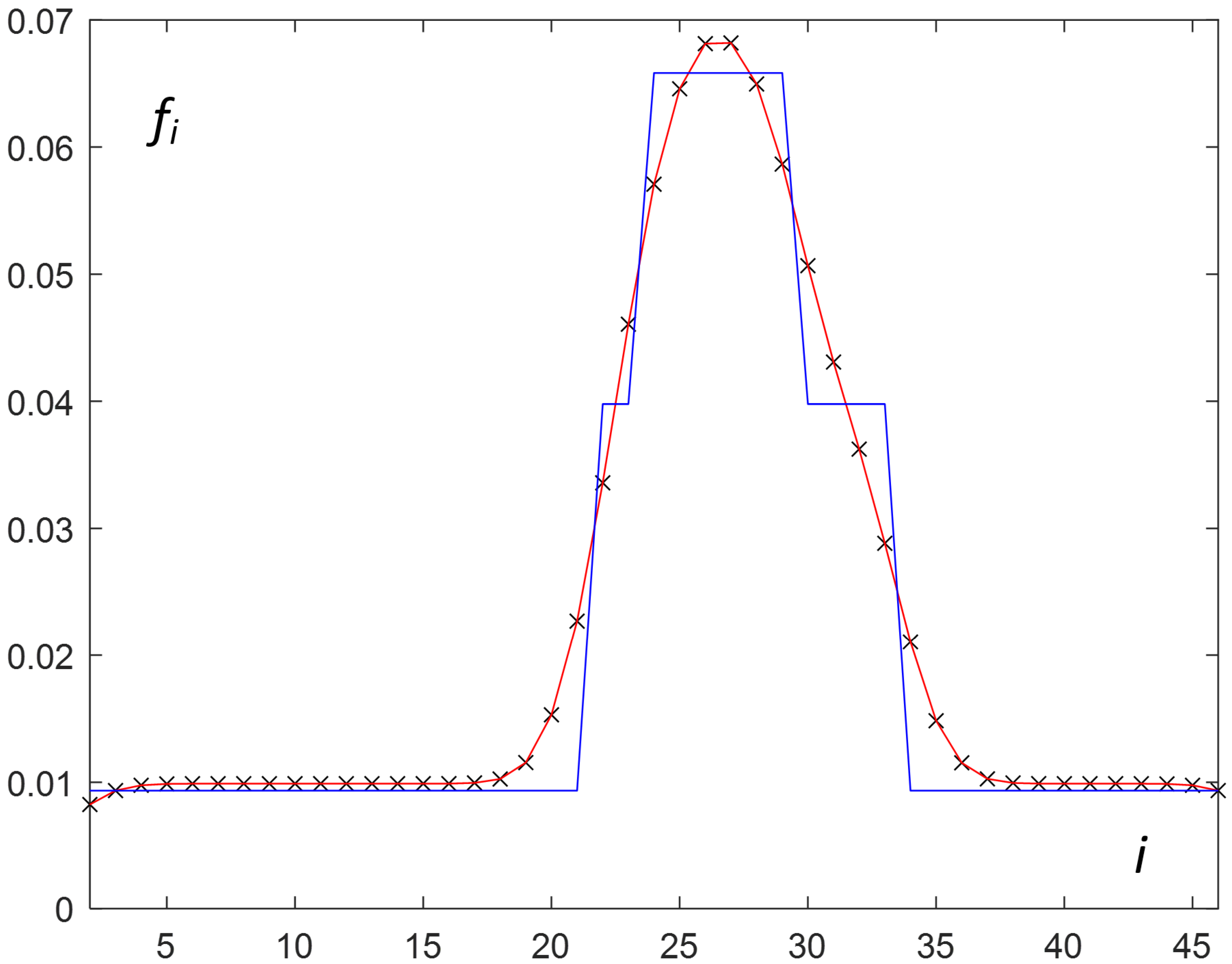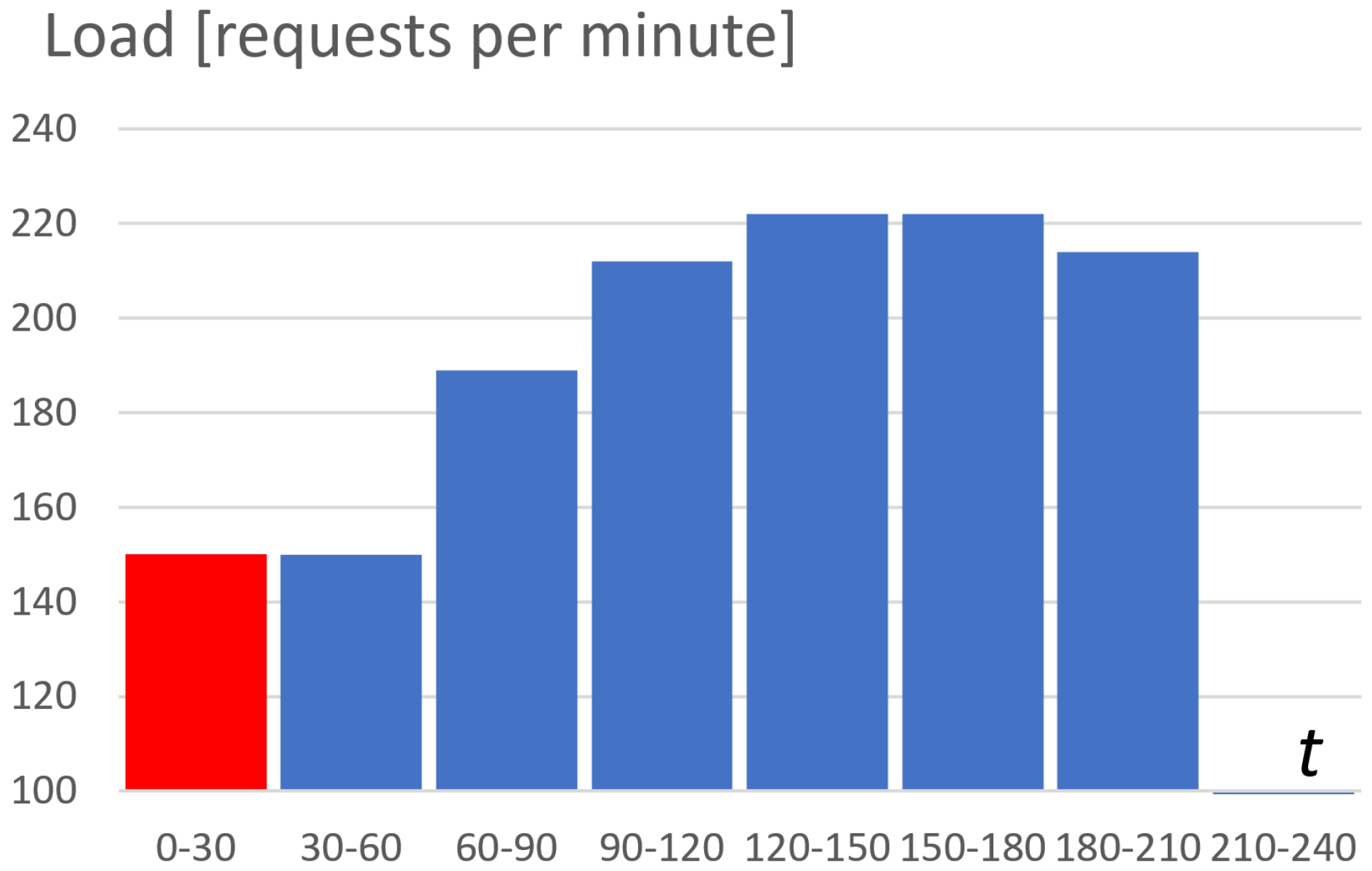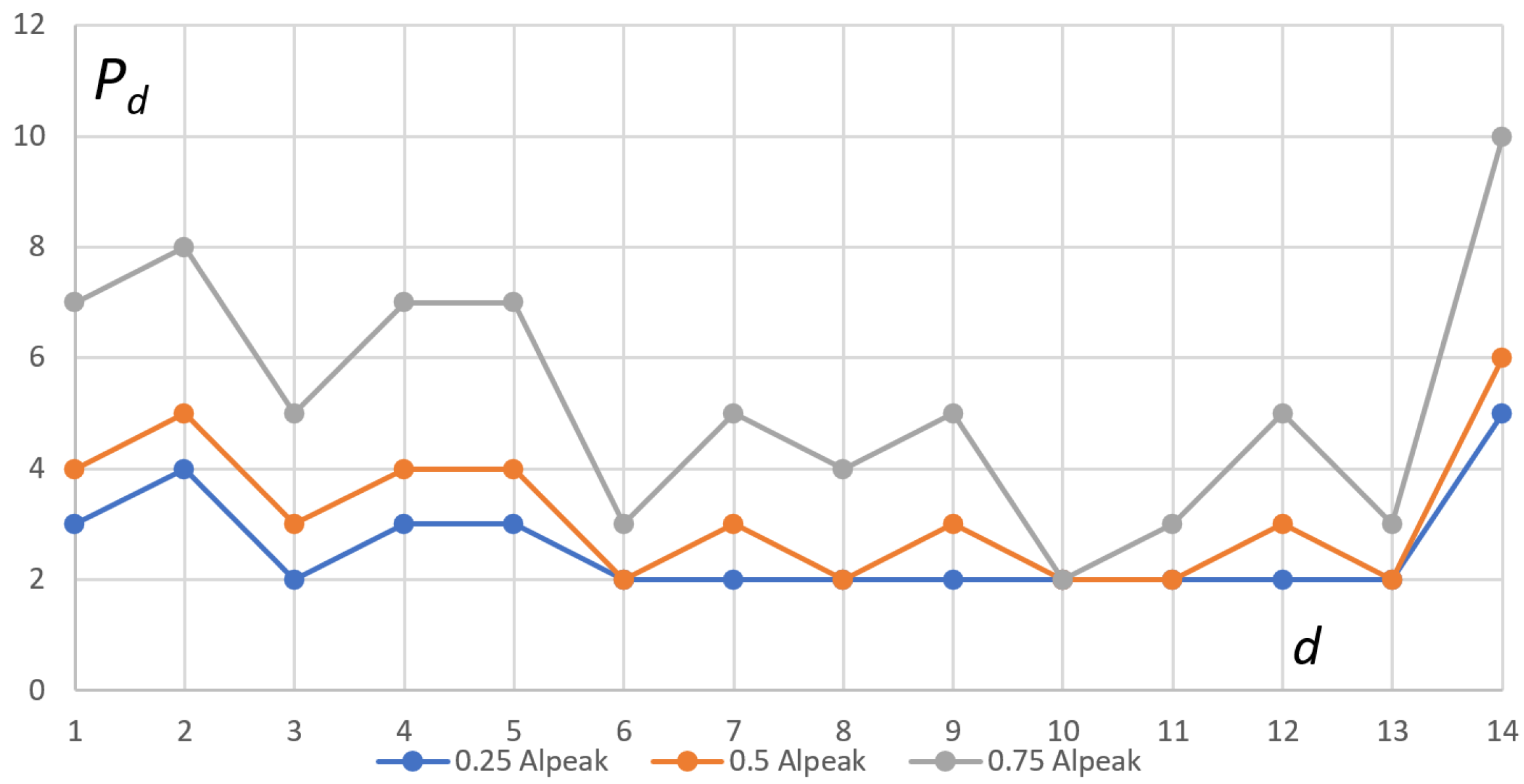Tuning a Kubernetes Horizontal Pod Autoscaler for Meeting Performance and Load Demands in Cloud Deployments
Abstract
1. Introduction
- The development of a methodology for acquiring a load profile aligned with specified external conditions/restrictions, grounded in the maximum entropy principle (Section 4.1.1);
- Proposing a method of improving the load profile during peak times through kernel smoothing (Section 4.1.2);
- The formulation of an optimal configuration methodology, determining the optimal values for the maximum limits of pods utilized by horizontal pod autoscalers (Section 4.2); the method’s advantage lies in its proposal to reduce the dimensionality of the autoscaler parameter space (Section 4.2.3); the problem is streamlined from the multidimensional to one-dimensional by distributing limit values for all deployments proportionally (see Equation (10)) to a singular limit value for the highest-load deployment;
- The successful application of the proposed method to derive optimal upper limits for the autoscaler (Table 7) under real-world conditions and in the context of a real system (Clinical Data Repository).
2. Background and Related Work
- TITLE-ABS-KEY ((k8s OR kubernetes) AND autoscaling AND (hpa OR autoscaler))
| Title | Year | Method Used |
|---|---|---|
| Toward Optimal Load Prediction and Customizable Autoscaling Scheme for Kubernetes [12] | 2023 | GRU |
| Intelligent Microservices Autoscaling Module Using Reinforcement Learning [13] | 2023 | RL |
| High Concurrency Response Strategy based on Kubernetes Horizontal Pod Autoscaler [14] | 2023 | custom formula |
| Proactive Horizontal Pod Autoscaling in Kubernetes Using Bi-LSTM [15] | 2023 | Bi–LSTM |
| Container Scaling Strategy Based on Reinforcement Learning [16] | 2023 | RL |
| Autoscaling Based on Response Time Prediction for Microservice Application in Kubernetes [10] | 2022 | ML |
| Traffic-Aware Horizontal Pod Autoscaler in Kubernetes-Based Edge Computing Infrastructure [17] | 2022 | custom formula |
| Horizontal Pod Autoscaling Based on Kubernetes with Fast Response and Slow Shrinkage [18] | 2022 | custom formula |
| K-AGRUED: A Container Autoscaling Technique for Cloud-based Web Applications in Kubernetes Using Attention-Based GRU Encoder-Decoder [19] | 2022 | GRU |
| LP-HPA:Load Predict-Horizontal Pod Autoscaler for Container Elastic Scaling [20] | 2022 | LSTM–GRU |
| DScaler: A Horizontal Autoscaler of Microservice Based on Deep Reinforcement Learning [21] | 2022 | RL |
| HANSEL: Adaptive Horizontal Scaling of Microservices Using Bi-LSTM [22] | 2021 | Bi–LSTM |
| Development of QoS-Aware Agents with Reinforcement Learning for Autoscaling of Microservices on The Cloud [23] | 2021 | RL |
| Deep Learning-Based Autoscaling Using Bidirectional Long Short-Term Memory for Kubernetes [24] | 2021 | Bi–LSTM |
| Adaptive Scaling of Kubernetes Pods [9] | 2020 | custom formula |
3. Materials and Methods
3.1. Materials
3.2. Methods and Methodology
4. Results
4.1. Obtaining the Peak Load Profile
- Determining a normalized load profile, characterized as a distribution that minimizes entropy while adhering to specified load requirements (Section 4.1.1);
- Extracting a segment of the load profile, specifically the load during peak periods, and subsequently smoothing its trajectory (Section 4.1.2);
- Scaling a normalized load during peak periods in accordance with predefined load requirements (Section 4.1.3).
4.1.1. Finding the Load Profile through the Maximum Entropy Principle
- —the m-th subsection;
- m—the number of subsections, where and ;
- —the number of requests in the m-th subsection ().
- The beginning of the domain of is ;
- The end of the domain of is ;
- The length of the domain equals:
| m | Beg-End of Sm Domain | [h] | [reqs] | [reqs/h] | |||
|---|---|---|---|---|---|---|---|
| 1 | 00:00–24:00 | 24 | 1 | 48 | 85,550 | 1 | 3564 |
| 2 | 11:00–17:00 | 6 | 22 | 33 | 56,780 | 0.66 | 9463 |
| 3 | 12:00–15:00 | 3 | 24 | 29 | 36,360 | 0.42 | 12,120 |
- and .
| i | 1 | 2 | … | 21 | 22 | 23 | 24 | 25 | … | 29 | 30 | … | 33 | 34 | … | 48 |
|---|---|---|---|---|---|---|---|---|---|---|---|---|---|---|---|---|
| m | ||||||||||||||||
| 1 | 1 | 1 | … | 1 | 1 | 1 | 1 | 1 | … | 1 | 1 | … | 1 | 1 | … | 1 |
| 2 | 0 | 0 | … | 0 | 1 | 1 | 1 | 1 | … | 1 | 1 | … | 1 | 0 | … | 0 |
| 3 | 0 | 0 | … | 0 | 0 | 0 | 1 | 1 | … | 1 | 0 | … | 0 | 0 | … | 0 |
| Algorithm 1: Finding the optimal load profile using Entropy and load constrains. |
(input: A, R; output F_opt) 01 lb = [0,…, 0] // lower boundaries for f_i 02 ub = [1,…, 1] // upper boundaries for f_i 03 F_opt = fmin (minus_entropy, A, R, lb, ub) |
- A = … % values are presented in Table 3
- R = [1, 0.66, 0.42]’
- lb = zeros(n,1); up = ones(n, 1) % lower and upper boundaries for f_i
- F_initial = rand(1, n) ./ n % initially, randomly around 1/n
- MinusEntropy = @(F) sum(F .* log2(F)) % defining of minus entropy function
- F_opt = fmincon(@MinusEntropy, F_initial, [], [], A, R, lb, ub)
- plot(F_opt)
4.1.2. Smoothing the Distribution of Load
| Algorithm 2: Calculating the smoothed load profile using kernel estimator. |
(input: F_opt; output: sF_opt) 01 // F_opt - vector of f_i for i = 1… n 02 // sF_opt - smoothed vector of f_i for i = 1… n 03 f_low = find the smallest value of f_i from F_opt 04 j = 1 05 sample = [] 06 for i = 1 to n 07 i_size = ceil (F_opt[i]/f_low) 08 // i_size-how many times index i should be represented in a sample 09 for k = 1 to i_size 10 sample [j++] = i 11 sF_opt = ks (sample, n) 12 // ks-generates a kernel-based density (n - values) using sample vector |
4.1.3. Obtaining the Approximate Load during a Peak
| Algorithm 3: Obtaining adjusted load profile during a peak according to load restrictions. |
(input: sF_opt, subs_constr; output: peak_load ) 01 // sF_opt-normalized smoothed vector of f_i for a whole-day section 02 // subs_constr-description of subsection and load constrains-Table 2 03 // peak_load-he vector of load during subsection that load peak exists 04 m_peak = find m index where R_m/T_m has biggest value in subs_constr 05 // m_peak is an index of the most loaded subsection S_m_peak 06 R_m_peak = find value of absolute load for m_peak subsection in subst_constr 07 // calculate the sum of normalized loads in intervals belonging to the S_m_peak 08 sum = 0 09 for each (I_k in subsection S_m_peak) 10 sum = sum + sF_opt[k] 11 // calculate peak load by scaling R_m_peak 12 peak_load = [] 13 for each (I_k in subsection S_m_peak) 14 peak_load[k] = sF_opt[k]/sum * R_m_peak |
4.2. Experimentally Obtaining the Upper Limits for Horizontal Autoscalers
- Experimentally detecting the pods (and deployments) involved in processing critical requests (Section 4.2.1);
- Experimentally obtaining the dependency between the numbers of pods of critical deployments (Section 4.2.2);
- Experimentally finding the optimal value of upper limits for autoscalers using the ratios from (3)—the crucial and final step in the method (Section 4.2.3).
4.2.1. Identifying Pods Involved in Handling Critical Requests
4.2.2. Experimental Pod Multiplicity Dependency Analysis
| k | 1 | 2 | 3 |
| 0.25 | 0.5 | 0.75 | |
| d | |||
| 1 | 3 | 4 | 7 |
| 2 | 4 | 5 | 8 |
| 3 | 2 | 3 | 5 |
| 4 | 3 | 4 | 7 |
| 5 | 3 | 4 | 7 |
| 6 | 2 | 2 | 3 |
| 7 | 2 | 3 | 5 |
| 8 | 2 | 2 | 4 |
| 9 | 2 | 3 | 5 |
| 10 | 2 | 2 | 2 |
| 11 | 2 | 2 | 3 |
| 12 | 2 | 3 | 5 |
| 13 | 2 | 2 | 3 |
| 14 | 5 | 6 | 10 |
- and . The deployment dependency for the considered example is shown in Table 5.
| d | 1 | 2 | 3 | 4 | 5 | 6 | 7 | 8 | 9 | 10 | 11 | 12 | 13 | 14 |
| 0.69 | 0.77 | 0.54 | 0.69 | 0.69 | 0.38 | 0.54 | 0.38 | 0.54 | 0.23 | 0.31 | 0.54 | 0.38 | 1.00 |
4.2.3. Finding the Optimal Setting of Parameter for HPAs
- J—the number of experiments;
- —the increase value (delta) of for the sequence of experiments;
- —the value of in the j-th experiment, where :
| d | 1 | 2 | 3 | 4 | 5 | 6 | 7 | 8 | 9 | 10 | 11 | 12 | 13 | 14 |
|---|---|---|---|---|---|---|---|---|---|---|---|---|---|---|
| j | ||||||||||||||
| 1 | 9 | 10 | 7 | 9 | 9 | 5 | 7 | 5 | 7 | 3 | 4 | 7 | 5 | 13 |
| 2 | 10 | 11 | 8 | 10 | 10 | 5 | 8 | 5 | 8 | 3 | 4 | 8 | 5 | 15 |
| 3 | 11 | 13 | 9 | 11 | 11 | 6 | 9 | 6 | 9 | 3 | 5 | 9 | 6 | 17 |
| 4 | 13 | 14 | 10 | 13 | 13 | 7 | 10 | 7 | 10 | 4 | 5 | 10 | 7 | 19 |
| 5 | 14 | 16 | 11 | 14 | 14 | 8 | 11 | 8 | 11 | 4 | 6 | 11 | 8 | 21 |
| 6 | 15 | 17 | 12 | 15 | 15 | 8 | 12 | 8 | 12 | 5 | 7 | 12 | 8 | 23 |
| 7 | 17 | 19 | 13 | 17 | 17 | 9 | 13 | 9 | 13 | 5 | 7 | 13 | 9 | 25 |
| 8 | 18 | 20 | 14 | 18 | 18 | 10 | 14 | 10 | 14 | 6 | 8 | 14 | 10 | 27 |
| 9 | 20 | 22 | 15 | 20 | 20 | 11 | 15 | 11 | 15 | 6 | 8 | 15 | 11 | 29 |
| d | 1 | 2 | 3 | 4 | 5 | 6 | 7 | 8 | 9 | 10 | 11 | 12 | 13 | 14 | SUM |
|---|---|---|---|---|---|---|---|---|---|---|---|---|---|---|---|
| j | |||||||||||||||
| 1 | 8.9667 | 9.9596 | 6.9975 | 8.9049 | 8.9107 | 4.9132 | 6.9836 | 4.9935 | 6.9835 | 2.9617 | 3.9966 | 6.9657 | 4.9467 | 12.9871 | 99.47 |
| 2 | 9.8266 | 10.8679 | 7.9727 | 9.8781 | 9.8281 | 4.8318 | 7.9174 | 4.8102 | 7.8292 | 2.8903 | 3.8404 | 7.9783 | 4.9985 | 14.8373 | 108.31 |
| 3 | 10.8747 | 12.9698 | 8.6026 | 10.7859 | 10.9816 | 5.9280 | 8.8461 | 5.8075 | 8.8270 | 2.8627 | 4.8560 | 8.8575 | 5.9870 | 16.7610 | 122.95 |
| 4 | 12.8006 | 13.6271 | 9.4928 | 12.6719 | 12.7243 | 6.6601 | 9.4421 | 6.9883 | 9.5221 | 3.7223 | 4.9112 | 9.9391 | 6.5998 | 18.5931 | 137.69 |
| 5 | 13.4130 | 15.6568 | 10.7430 | 13.4009 | 13.6905 | 7.3995 | 10.3779 | 7.4713 | 10.6494 | 3.3574 | 5.9280 | 10.3957 | 7.5150 | 20.9460 | 150.94 |
| 6 | 14.8425 | 16.9452 | 11.3057 | 14.4380 | 14.9443 | 7.6105 | 11.2753 | 7.4316 | 11.6597 | 4.2873 | 6.3095 | 11.8167 | 7.6492 | 22.4450 | 162.96 |
| 7 | 16.4658 | 18.4884 | 12.9705 | 16.8384 | 16.4093 | 8.4676 | 12.3611 | 8.3710 | 12.6239 | 4.5416 | 6.5411 | 12.8192 | 8.6201 | 24.4102 | 179.93 |
| 8 | 17.0785 | 19.0732 | 13.8264 | 17.7213 | 17.8322 | 8.3784 | 13.9572 | 8.8037 | 13.0786 | 5.9261 | 6.5446 | 12.8818 | 8.5969 | 25.6859 | 189.38 |
| 9 | 19.9167 | 21.6530 | 13.2770 | 19.8088 | 19.1963 | 9.3961 | 13.3651 | 9.7983 | 13.4372 | 5.7085 | 6.0025 | 12.9293 | 8.9375 | 27.8380 | 201.26 |
- Me—the median of the execution times of the critical request;
- %error—the relative error (the number of failed requests compared to the total number of requests).
- NoN—the mean number of nodes of the Kubernetes cluster used by the considered system.
| j | NoN | Me [s] | %error |
|---|---|---|---|
| 1 | 13.72 | 61.1 | 87.00% |
| 2 | 14.10 | 51 | 67.50% |
| 3 | 18.29 | 15 | 19.12% |
| 4 | 20.39 | 7.6 | 9.35% |
| 5 | 25.15 | 1.68 | 4.35% |
| 6 | 27.12 | 1.43 | 3.75% |
| 7 | 29.03 | 1.33 | 4.49% |
| 8 | 30.23 | 1.23 | 9.10% |
| 9 | 31.23 | 1.21 | 11.95% |
5. Conclusions
Author Contributions
Funding
Institutional Review Board Statement
Informed Consent Statement
Data Availability Statement
Conflicts of Interest
Abbreviations
| CDR | Clinical data repository |
| GRU | Gated recurrent unit |
| HIS | Hospital information system |
| HPA | Horizontal pod autoscaler |
| HPC | High performance computing |
| K8s | Kubernetes |
| KRM | Kubernetes resource metric |
| LSTM | Long short-term memory |
| LXC | Linux containers |
| ML | Machine learning |
| PCM | Prometheus custom metrics |
| QoS | Quality of service |
| RL | Reinforcement learning |
| TCO | Total cost of ownership |
References
- Armbrust, M.; Fox, A.; Griffith, R.; Joseph, A.D.; Katz, R.; Konwinski, A.; Lee, G.; Patterson, D.; Rabkin, A.; Stoica, I.; et al. A View of Cloud Computing. Commun. ACM 2010, 53, 50–58. [Google Scholar] [CrossRef]
- Burns, B.; Grant, B.; Oppenheimer, D.; Brewer, E.A.; Wilkes, J. Borg, Omega, and Kubernetes. Commun. ACM 2016, 59, 50–57. [Google Scholar] [CrossRef]
- Horizontal Pod Autoscaling. Available online: https://kubernetes.io/docs/tasks/run-application/horizontal-pod-autoscale/ (accessed on 6 November 2023).
- Marathe, N.; Gandhi, A.; Shah, J.M. Docker swarm and kubernetes in cloud computing environment. In Proceedings of the 2019 3rd International Conference on Trends in Electronics and Informatics (ICOEI), Tirunelveli, India, 23–25 April 2019; pp. 179–184. [Google Scholar]
- Xavier, M.G.; Neves, M.V.; Rossi, F.D.; Ferreto, T.C.; Lange, T.; De Rose, C.A. Performance evaluation of container-based virtualization for high performance computing environments. In Proceedings of the 2013 21st Euromicro International Conference on Parallel, Distributed, and Network-Based Processing, Belfast, UK, 27 February–1 March 2013; pp. 233–240. [Google Scholar]
- Verreydt, S.; Beni, E.H.; Truyen, E.; Lagaisse, B.; Joosen, W. Leveraging Kubernetes for Adaptive and Cost-Efficient Resource Management. In Proceedings of the WOC’19: 5th International Workshop on Container Technologies and Container Clouds, Davis, CA, USA, 9–13 December 2019; Association for Computing Machinery: New York, NY, USA, 2019; pp. 37–42. [Google Scholar] [CrossRef]
- Tran, M.N.; Vu, D.D.; Kim, Y. A Survey of Autoscaling in Kubernetes. In Proceedings of the 2022 Thirteenth International Conference on Ubiquitous and Future Networks (ICUFN), Barcelona, Spain, 5–8 July 2022; pp. 263–265. [Google Scholar] [CrossRef]
- Nguyen, T.T.; Yeom, Y.J.; Kim, T.; Park, D.H.; Kim, S. Horizontal Pod Autoscaling in Kubernetes for Elastic Container Orchestration. Sensors 2020, 20, 4621. [Google Scholar] [CrossRef] [PubMed]
- Balla, D.; Simon, C.; Maliosz, M. Adaptive scaling of Kubernetes pods. In Proceedings of the NOMS 2020—2020 IEEE/IFIP Network Operations and Management Symposium, Budapest, Hungary, 20–24 April 2020; pp. 1–5. [Google Scholar] [CrossRef]
- Pramesti, A.A.; Kistijantoro, A.I. Autoscaling Based on Response Time Prediction for Microservice Application in Kubernetes. In Proceedings of the 2022 9th International Conference on Advanced Informatics: Concepts, Theory and Applications (ICAICTA), Tokoname, Japan, 28–29 September 2022; pp. 1–6. [Google Scholar] [CrossRef]
- Ferreira Gregorio, V.; Pié, L.; Terceño, A. A Systematic Literature Review of Bio, Green and Circular Economy Trends in Publications in the Field of Economics and Business Management. Sustainability 2018, 10, 4232. [Google Scholar] [CrossRef]
- Mondal, S.K.; Wu, X.; Kabir, H.M.D.; Dai, H.N.; Ni, K.; Yuan, H.; Wang, T. Toward Optimal Load Prediction and Customizable Autoscaling Scheme for Kubernetes. Mathematics 2023, 11, 2675. [Google Scholar] [CrossRef]
- Abdel Khaleq, A.; Ra, I. Intelligent microservices autoscaling module using reinforcement learning. Clust. Comput. 2023, 26, 2789–2800. [Google Scholar] [CrossRef]
- Huo, Q.; Li, C.; Li, S.; Xie, Y.; Li, Z. High Concurrency Response Strategy based on Kubernetes Horizontal Pod Autoscaler. J. Phys. Conf. Ser. 2023, 2451, 012001. [Google Scholar] [CrossRef]
- Kakade, S.; Abbigeri, G.; Prabhu, O.; Dalwayi, A.; Narayan, G.; Patil, S.P.; Sunag, B. Proactive Horizontal Pod Autoscaling in Kubernetes using Bi-LSTM. In Proceedings of the IEEE International Conference on Contemporary Computing and Communications (InC4), Bangalore, India, 21–22 April 2023. [Google Scholar] [CrossRef]
- Wang, H.; Zhang, C.; Li, J.; Bao, D.; Xu, J. Container Scaling Strategy Based on Reinforcement Learning. Secur. Commun. Netw. 2023, 2023, 7400235. [Google Scholar] [CrossRef]
- Phuc, L.H.; Phan, L.A.; Kim, T. Traffic-Aware Horizontal Pod Autoscaler in Kubernetes-Based Edge Computing Infrastructure. IEEE Access 2022, 10, 18966–18977. [Google Scholar] [CrossRef]
- Huo, Q.; Li, S.; Xie, Y.; Li, Z. Horizontal Pod Autoscaling based on Kubernetes with Fast Response and Slow Shrinkage. In Proceedings of the 2022 International Conference on Artificial Intelligence, Information Processing and Cloud Computing (AIIPCC), Kunming, China, 19–21 August 2022; pp. 203–206. [Google Scholar] [CrossRef]
- Dogani, J.; Khunjush, F.; Seydali, M. K-AGRUED: A Container Autoscaling Technique for Cloud-based Web Applications in Kubernetes Using Attention-based GRU Encoder-Decoder. J. Grid Comput. 2022, 20, 40. [Google Scholar] [CrossRef]
- Xu, Y.; Qiao, K.; Wang, C.; Zhu, L. LP-HPA:Load Predict-Horizontal Pod Autoscaler for Container Elastic Scaling. In Proceedings of the CSSE ’22: Proceedings of the 5th International Conference on Computer Science and Software Engineering, Guilin, China, 21–23 October 2022; pp. 591–595. [Google Scholar] [CrossRef]
- Xiao, Z.; Hu, S. DScaler: A Horizontal Autoscaler of Microservice Based on Deep Reinforcement Learning. In Proceedings of the 2022 23rd Asia-Pacific Network Operations and Management Symposium (APNOMS), Takamatsu, Japan, 28–30 September 2022. [Google Scholar] [CrossRef]
- Yan, M.; Liang, X.; Lu, Z.; Wu, J.; Zhang, W. HANSEL: Adaptive horizontal scaling of microservices using Bi-LSTM. Appl. Soft Comput. 2021, 105, 107216. [Google Scholar] [CrossRef]
- Khaleq, A.A.; Ra, I. Development of QoS-aware agents with reinforcement learning for autoscaling of microservices on the cloud. In Proceedings of the 2021 IEEE International Conference on Autonomic Computing and Self-Organizing Systems Companion (ACSOS-C), Washington, DC, USA, 27 September–1 October 2021; pp. 13–19. [Google Scholar] [CrossRef]
- Dang-Quang, N.M.; Yoo, M. Deep learning-based autoscaling using bidirectional long short-term memory for kubernetes. Appl. Sci. 2021, 11, 3835. [Google Scholar] [CrossRef]
- Baptista, T.; Silva, L.B.; Costa, C. Highly scalable medical imaging repository based on Kubernetes. In Proceedings of the 2021 IEEE International Conference on Bioinformatics and Biomedicine (BIBM), Houston, TX, USA, 9–12 December 2021; pp. 3193–3200. [Google Scholar]
- Augustyn, D.R.; Wyciślik, Ł.; Sojka, M. The FaaS-Based Cloud Agnostic Architecture of Medical Services—Polish Case Study. Appl. Sci. 2022, 12, 7954. [Google Scholar] [CrossRef]
- Masouros, D.; Koliogeorgi, K.; Zervakis, G.; Kosvyra, A.; Chytas, A.; Xydis, S.; Chouvarda, I.; Soudris, D. Co-design implications of cost-effective on-demand acceleration for cloud healthcare analytics: The AEGLE approach. In Proceedings of the 2019 Design, Automation & Test in Europe Conference & Exhibition (DATE), Florence, Italy, 25–29 March 2019; pp. 622–625. [Google Scholar]
- Aceto, G.; Persico, V.; Pescapé, A. Industry 4.0 and health: Internet of things, big data, and cloud computing for healthcare 4.0. J. Ind. Inf. Integr. 2020, 18, 100129. [Google Scholar] [CrossRef]
- Augustyn, D.R.; Wyciślik, Ł.; Sojka, M. The Cloud-Enabled Architecture of the Clinical Data Repository in Poland. Sustainability 2021, 13, 14050. [Google Scholar] [CrossRef]
- Zipkin. Available online: https://zipkin.io/ (accessed on 6 November 2023).
- Jaeger. Available online: https://www.jaegertracing.io/ (accessed on 6 November 2023).
- Prometheus. Available online: https://prometheus.io/ (accessed on 6 November 2023).
- Grafana. Available online: https://grafana.com/ (accessed on 6 November 2023).
- Gatling. Available online: https://gatling.io/ (accessed on 6 November 2023).
- Guiasu, S.; Shenitzer, A. The principle of maximum entropy. Math. Intell. 1985, 7, 42–48. [Google Scholar] [CrossRef]
- Cesari, A.; Reißer, S.; Bussi, G. Using the maximum entropy principle to combine simulations and solution experiments. Computation 2018, 6, 15. [Google Scholar] [CrossRef]
- Jaynes, E.T. On the rationale of maximum-entropy methods. Proc. IEEE 1982, 70, 939–952. [Google Scholar] [CrossRef]
- Find Minimum of Constrained Nonlinear Multivariable Function. Available online: https://uk.mathworks.com/help/optim/ug/fmincon.html (accessed on 6 November 2023).
- Chung, M.K. Gaussian kernel smoothing. arXiv 2020, arXiv:2007.09539. [Google Scholar]
- Peter D, H. Kernel estimation of a distribution function. Commun. Stat.Theory Methods 1985, 14, 605–620. [Google Scholar] [CrossRef]
- Ghosh, S. Kernel Smoothing: Principles, Methods and Applications; John Wiley & Sons: Hoboken, NJ, USA, 2018. [Google Scholar]
- Kernel Smoothing Function Estimate for Univariate and Bivariate Data. Available online: https://uk.mathworks.com/help/stats/ksdensity.html/ (accessed on 6 November 2023).






Disclaimer/Publisher’s Note: The statements, opinions and data contained in all publications are solely those of the individual author(s) and contributor(s) and not of MDPI and/or the editor(s). MDPI and/or the editor(s) disclaim responsibility for any injury to people or property resulting from any ideas, methods, instructions or products referred to in the content. |
© 2024 by the authors. Licensee MDPI, Basel, Switzerland. This article is an open access article distributed under the terms and conditions of the Creative Commons Attribution (CC BY) license (https://creativecommons.org/licenses/by/4.0/).
Share and Cite
Augustyn, D.R.; Wyciślik, Ł.; Sojka, M. Tuning a Kubernetes Horizontal Pod Autoscaler for Meeting Performance and Load Demands in Cloud Deployments. Appl. Sci. 2024, 14, 646. https://doi.org/10.3390/app14020646
Augustyn DR, Wyciślik Ł, Sojka M. Tuning a Kubernetes Horizontal Pod Autoscaler for Meeting Performance and Load Demands in Cloud Deployments. Applied Sciences. 2024; 14(2):646. https://doi.org/10.3390/app14020646
Chicago/Turabian StyleAugustyn, Dariusz R., Łukasz Wyciślik, and Mateusz Sojka. 2024. "Tuning a Kubernetes Horizontal Pod Autoscaler for Meeting Performance and Load Demands in Cloud Deployments" Applied Sciences 14, no. 2: 646. https://doi.org/10.3390/app14020646
APA StyleAugustyn, D. R., Wyciślik, Ł., & Sojka, M. (2024). Tuning a Kubernetes Horizontal Pod Autoscaler for Meeting Performance and Load Demands in Cloud Deployments. Applied Sciences, 14(2), 646. https://doi.org/10.3390/app14020646






